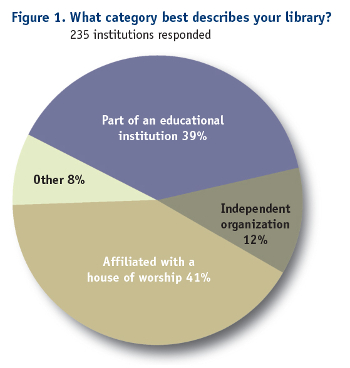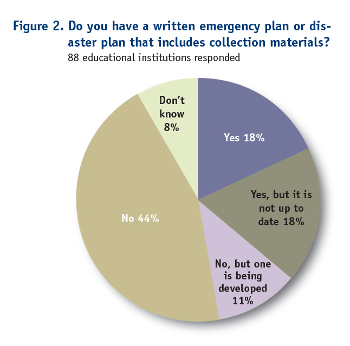A rare Bible printed in the late 1770s lies on the shelf in a locked room, but inside, the temperature fluctuates by as much as 50 degrees during the course of a year.
Letters in which a seminary founder recounts his experiences as a missionary are carefully stored in a plain manila folder, but the folder’s acid content is slowly turning the letters to dust. Recordings of sermons given by prominent visiting theologians are placed willy-nilly in a box at the back of a closet, mixed in with tapes of student choir performances and videotapes of old TV shows—essentially lost and unknown because they are uncatalogued.
These are just some of the situations found in libraries and archives all over the world in which insufficient staffing and funding are threatening valuable heritage collections.
Concern about these situations has inspired a major theological library association to lead an effort to determine the current status for the care of religious and theological collections. Not surprisingly, the results are grim: At many small institutions, special collections are ignored, underfunded, and threatened.
Background
In 2013, the Institute of Museum and Library Services (IMLS), a federal agency providing grants to cultural heritage organizations, awarded a grant to the American Theological Library Association (ATLA), the Catholic Library Association (CLA), and the Association of Jewish Libraries (AJL). The grant’s purpose: to assess care, preservation, and access in small libraries housing theological and religious studies collections. The project’s main activity was a spring 2014 survey of small libraries and archives that are based at theological and religious studies organizations. A report on the survey was published in late 2014 and is available at www.bit.ly/1m4KRNF.
New definitions
The survey was targeted to organizations with staffs of fewer than five and budgets of less than $500,000. In addition to member libraries and archives of ATLA, CLA, and AJL, the project reached out to other theological and religious collections. The resulting 235 responses represent one of the largest surveys ever completed on preservation and digital practices in theological and religious library and archival organizations.
 The three sponsoring library associations worked with nationally recognized cultural heritage market research consultants Tom Clareson and Liz Bishoff. They defined the survey’s target audience as cultural heritage institutions that are part of a formally established organization and have a library, archive, or other research collection that includes religious or theological materials. Furthermore, each organization had to have historical or rare materials as part of the collection and had to have at least one person responsible for collection’s management who could serve as the contact.
The three sponsoring library associations worked with nationally recognized cultural heritage market research consultants Tom Clareson and Liz Bishoff. They defined the survey’s target audience as cultural heritage institutions that are part of a formally established organization and have a library, archive, or other research collection that includes religious or theological materials. Furthermore, each organization had to have historical or rare materials as part of the collection and had to have at least one person responsible for collection’s management who could serve as the contact.
Altogether, these demographics on staff, budget size, and organizational and collections types were synthesized to develop a definition of a “small religious or theological library or archive” — a definition that had not before existed in library and archival research literature.
A wide variety of organization types responded to the survey: academic institutions; churches, synagogues, and other houses of worship; independent libraries and archives; and other organizations.
Overall findings
The survey results show some broad trends among all the participating organizations:
- Preservation policies. Many organizations include preservation in their mission statements but nevertheless lack basic policies about preserving and digitizing their collections.
- Disaster plans. Disaster plans, digital collection plans and policies, and environmental monitoring and control procedures are sorely lacking in the surveyed collections — especially considering that everyday events like water leaks and high humidity can cause nearly as much damage as fires and floods.
- Professional assessment. A “preservation needs assessment survey” conducted by a conservation professional can help organizations understand the condition of their collections and the vulnerabilities of their buildings to damage and disasters.
- Staffing shortages. A majority of the surveyed institutions with budgets of less than $100,000 do not have the staff, financial resources, or policies to ensure adequate preservation of their collections.
All institutions, no matter their budget size, need to improve staffing levels and financial support for preservation. Among the activities that additional funding could support: collection processing, cataloging, and the development of finding aids to increase the discoverability and use of collections.
What’s unique to theological schools
In many cases, the libraries and archives located at schools fared better than the other libraries queried in the survey — especially in the areas of institutional budget, paid and student staffing, open hours, the variety of material types held in collections, participation in preservation training, and professional affiliations. In fact, many of the schools responding to the survey were larger than the defined parameters for “small institutions.”
 However, the surveyed schools and educational institutions can still improve their preservation activities. For example, more than 60 percent of the libraries and archives at educational institutions do not have a written preservation/conservation plan for the maintenance, care, repair, and protection of collections. Almost 70 percent have not had a formal preservation or conservation survey to assess the condition of their collections.
However, the surveyed schools and educational institutions can still improve their preservation activities. For example, more than 60 percent of the libraries and archives at educational institutions do not have a written preservation/conservation plan for the maintenance, care, repair, and protection of collections. Almost 70 percent have not had a formal preservation or conservation survey to assess the condition of their collections.
Overall, 44 percent of the queried institutions do not have a written emergency or disaster plan. Looking at three categories related to planning documents (“have a plan,” “have a plan but it is not updated,” “do not have a plan but one is being developed”), around 47 percent do have a plan in some state of readiness.
Responses from theological schools and educational institutions
When asked if they have an annual budget specifically for preservation activities, 16 percent of institutions stated they have an annual preservation budget of $1,001 to $2,500, and 13 percent said their preservation budget is $5,001 or more. Nearly 23 percent have no preservation or conservation budget, and 24 percent have a preservation budget of $1 to $500.
Just over 53 percent of the respondents from educational institutions create digital resources from their physical collections, but 61 percent are not yet collecting “born-digital” materials (which do not have a print counterpart). Many of the organizations creating or collecting digital materials do not have specific policies dealing with their digital collections, but more than 36 percent of respondents have a “digital collection development policy” to help select materials to digitize.
Libraries and archives at religious and theological schools back up their digital files, mainly on a daily or weekly basis, and they are following best practices by storing their backup files in multiple locations. However, only 6 percent of respondents have a documented digital preservation policy.
There were several areas in which religious and theological libraries showed special need. For example, more than 30 percent of the survey respondents expressed an urgent need for environmental controls to maintain temperature and humidity at safe levels. When asked about the preservation training they need, respondents expressed the highest level of desire for training on advocacy, fundraising or grant writing, disaster preparedness and recovery, and digital repository selection or implementation.
Takeaways
The greatest need at religiously oriented archives and libraries may also be the hardest to achieve: Increasing the number of staff, and increasing the time that current staff spends on preservation and digitization. Both of these require increased budgets for library and archival activities.
An action that may be more achievable in the near term is preservation planning — especially conducting a preservation needs assessment site survey. This onsite survey can be a key step in helping an organization develop a preservation action plan for protecting the collection. The lack of environmental controls is a major problem for survey respondents across all library and archives types and sizes. Continuing education and information that focus on the development of environmental monitoring practices and suggest better methods of environmental control would be valuable.
Librarians and archivists at theological schools may be able to provide preservation information, model policies, and best-practice case studies for their colleagues at smaller institutions (like collections held by congregations within the theological school’s geographic region or faith tradition).
For more information on the results of the “In Good Faith” project, and how you can assist theological libraries and archives in the protection of their most important collections, contact ATLA at MemberRep@atla.com.
Taking just a few simple steps can help ensure that the valuable books, papers, recordings, and other materials housed at your institution are preserved for future generations of scholars and researchers.
Questions for the seminary board
- Does your library or archives have a disaster recovery plan in place? Is it up to date? When is the last time that a qualified consultant assessed the current environmental conditions in your library or archives?
- Has your librarian or archivist identified the most valuable materials in your collection—especially those that are unique to your institution?
- Do your library staff members participate in local, regional, or national library consortia? Do they attend seminars and educational events that support preservation? What professional development funds are available that allow librarians or archivists to attend educational events related to preservation?
- Is the school’s fundraising staff familiar with the library’s special collections? Sometimes individual donors can be tapped for a special project like protecting the papers of a denominational founder or retired leader.
- If you are planning a capital campaign for the entire institution, what particular capital needs for the library or archives can be folded into the larger campaign?